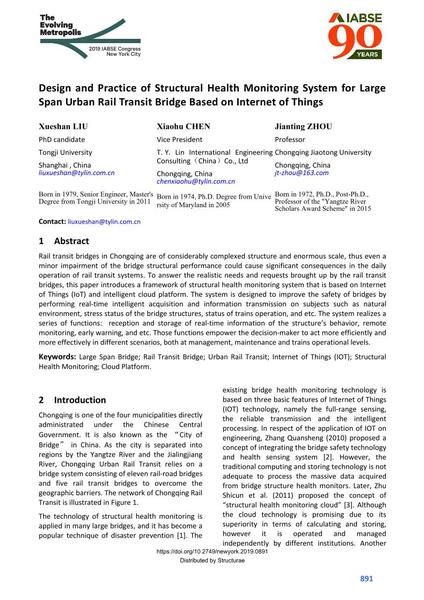Design and Practice of Structural Health Monitoring System for Large Span Urban Rail Transit Bridge Based on Internet of Things

|
|
|||||||||||
Bibliografische Angaben
| Autor(en): |
Xueshan Liu
(Tongji University)
Xiaohu Chen (T. Y. Lin International Engineering Consulting (China) Co., Ltd) Jianting Zhou (Chongqing Jiaotong University) |
||||
|---|---|---|---|---|---|
| Medium: | Tagungsbeitrag | ||||
| Sprache(n): | Englisch | ||||
| Tagung: | IABSE Congress: The Evolving Metropolis, New York, NY, USA, 4-6 September 2019 | ||||
| Veröffentlicht in: | The Evolving Metropolis | ||||
|
|||||
| Seite(n): | 891-896 | ||||
| Anzahl der Seiten (im PDF): | 6 | ||||
| DOI: | 10.2749/newyork.2019.0891 | ||||
| Abstrakt: |
Rail transit bridges in Chongqing are of considerably complexed structure and enormous scale, thus even a minor impairment of the bridge structural performance could cause significant consequences in the daily operation of rail transit systems. To answer the realistic needs and requests brought up by the rail transit bridges, this paper introduces a framework of structural health monitoring system that is based on Internet of Things (IoT) and intelligent cloud platform. The system is designed to improve the safety of bridges by performing real-time intelligent acquisition and information transmission on subjects such as natural environment, stress status of the bridge structures, status of trains operation, and etc. The system realizes a series of functions: reception and storage of real-time information of the structure’s behavior, remote monitoring, early warning, and etc. Those functions empower the decision-maker to act more efficiently and more effectively in different scenarios, both at management, maintenance and trains operational levels. |
||||
